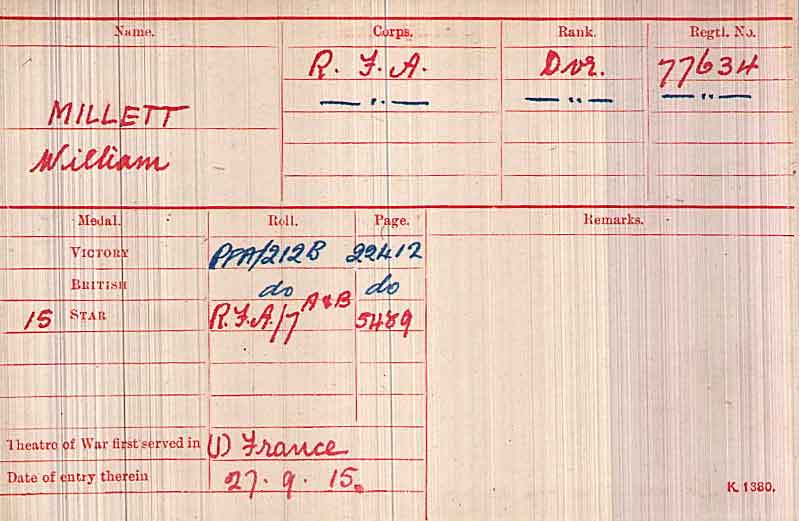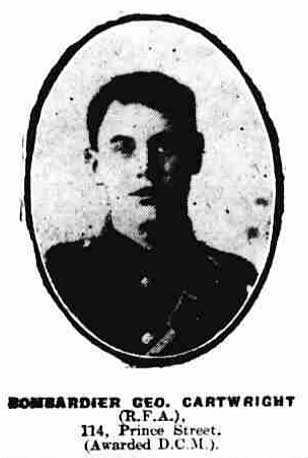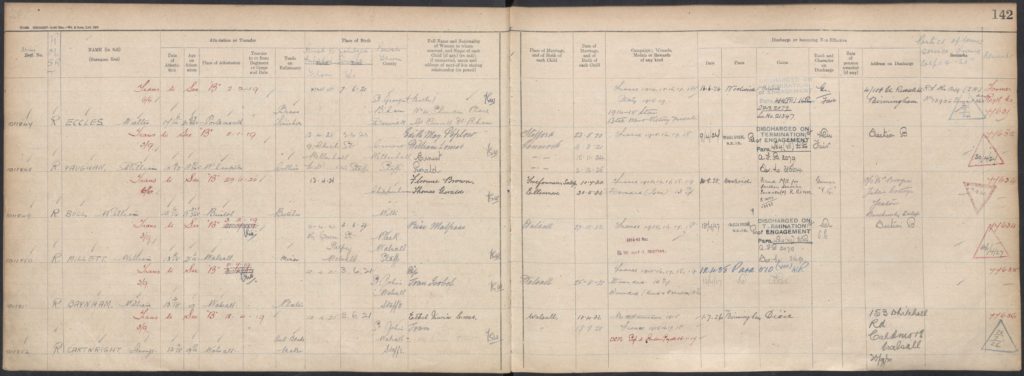A 'Walsall Pals' story
On 13th April 1915, three young local men enlisted into the Army at Walsall – they were William Millett (19), George Cartwright (21) and my grandfather William Baynham (18).
The 1911 census showed that all three were from ‘The Pleck’, an area in Walsall; both my grandfather and George Cartwright were living in Prince Street – William at number 151 and George at number 114. George (then 14) was working as an apprentice awl and blade maker and living with his father (also George, a policeman), mother and seven siblings. William Millett (then 17) was working as a brush maker and living at 41 New Mills Street with his father (also William, a railway engine driver), mother and three siblings. My grandfather (then 13) was working as an apprentice whip maker. By the time of their enlistment, William Millett was working as a miner and my grandfather as a plater in a galvanised iron works.
All three joined the Royal Field Artillery and were initially posted to No.5 Depot, at Athlone in Ireland, where they were allocated numbers 77634, 77635 and 77636 and did their basic training. The two Williams were then sent to France and George to The Mediterranean.
William Baynham, my grandfather
William Baynham landed in France on 26th September 1915, as a general reinforcement, and after a few months with 8th Divisional Ammunition Column joined 32nd Battery, 33rd Brigade as a gun layer in an 18-pounder gun crew. His complete war story is told here.
William Millett
William Millett landed in France on the day after my grandfather, on 27th September 1915.
Like my grandfather, he had done his basic training from April to August 1915 in 5B Reserve Brigade at Athlone Depot, so perhaps they had learned their basic skills together (and been out of camp for a few beers together in the evenings?).
Unlike my grandfather, he had been posted to a unit (rather than another Reserve Brigade) on 29th August while still at Athlone – he joined ‘B’ Battery of 112 Brigade in 25th Division, as a driver. A month later, on 22nd September 1915, he was moved into Brigade HQ, again as a driver; amazingly, he remained in this role at Brigade HQ throughout nearly all of the war – until May 1918!
112 Brigade’s War Diary shows that it spent September 1915 in ‘brigade training’ at Leipzig Barracks in Aldershot, leaving there in 11 trains bound for Southampton in the early hours of 26th September and setting sail for Le Havre the same evening. Disembarking the following morning, the brigade then made its way by train and on foot via Caestre and Pradelles to join 25th Division at Le Bizet, just south of Ploegsteert (‘Plug Street’, as the Tommies called it). Its guns fired their first rounds on 1st October and came under enemy fire for the first time on 4th.
Brigade HQ was up with the guns here and the war diary for 6th October reported that ‘two telephonists were disturbed by someone round Brigade Headquarters billet. They chased him and one man (not Millett) was fired at and wounded in the leg; he replied but no result was discovered’. 112’s guns were used mostly to cover known enemy trenches and in support of infantry action, plus the usual wire-cutting duties. Incoming fire was varied and it appears that enemy snipers. especially the ones in trees, were a constant threat. The war diary is very detailed and records the weather conditions throughout each day in addition to the number, type and target of all shells fired and full details of incoming enemy fire.
The Brigade remained at Le Bizet until it was relieved in late January 1916; it marched to the rest area at Caestre where it stayed until mid March. By late April, after a period around Averdoingt, the guns had moved into positions forward of Villers Au Bois and registered on the enemy’s front line and support trenches; HQ was in dug-outs in the trenches near Cabaret Rouge. The war diary now notes the place of action as ‘In the Field’ and there is plenty of hostile fire! No damage is recorded until 3rd May when a direct hit on a gun killed the layer and wounded the No.1. However, the gunners continued to ‘receive some attention’ from the enemy and its trench mortars were said to be ‘greatly annoying’ the infantry ahead of them and then on 21st May: “the Batteries of this Brigade were heavily shelled all through the day, causing a great many casualties. Gas, tear shells were used by the enemy during this bombardment”. As a result, the brigade was relieved the next day and HQ was pulled out of its forward position; all members returned initially to Villers Au Bois, then moved further west to the wagon lines at Cambligneuil and finally withdrew to the camp at St. Michel where they ‘rested’ (general duties, plus lots of training days) until mid June.
They were not involved in the first few days of the Battle of the Somme; from St. Michel they went via Occoches to Montrelet, where the men engaged in more general duties, training and inspections while the C.O. and various officers went forward to reconnoitre. On 28th June the Brigade marched to Harponville and by 1st July was camped in the wood at Vadencourt where it remained until 5th, while officers went forward to look at the firing line. Orders were then received to leave that evening for action – presumably somewhere east of Bouzincourt where the wagon lines were left.
On the nights of 3rd and 4th July my grandfather’s Brigade (33rd) had been relieved after prolonged action near Albert and was starting its journey westward to Marle-Les-Mines, via Le Mesge. At this point in the war, the two Williams might have been less than 3 miles apart …
According to its war diary for July 1916, the guns of 112th Brigade engaged in heavy barrages on and around Pozieres (and beyond, to Courcelette Chimney and Mouquet Farm) targetting enemy trenches, cutting wire and also in support of Australian infantry attacks; incoming shells were hitting Aveluy, Authuille Wood and both Sausage Valley and Mash Valley. This suggests that 112th was maybe positioned just east of where William Baynham had been (all these places are clearly marked on Captain Davison’s map of the front). At the end of the month the entire Brigade moved to new positions close to Authuille Wood and continued fighting on the same front right through until late November when it was relieved and marched in a wide arc north into billets at Meteren.
Just four days later, the Brigade, now re-organised into 6-gun batteries, was again at the Front – this time in a much quieter zone just north of where it had been at the end of 1915; HQ is mentioned on 30th December 1916, when it moves to ‘hutments on the Ploegsteert-Romarin road’. The Brigade was relieved at the end of February 1917 and went into rest billets at Esquerdes where it engaged in lots of training (especially signalling), cleaning, inspections and a Divisional Horse Show on 18th March in which it won 5 first prizes and numerous seconds and thirds!
By late March 1917 it was on the move again, this time to lines just east of Steenwerke (now Steenwerck) where most of the men went into more training sessions while the officers met with the 1st N.Z.F.A Brigade to be relieved at Neuve Eglise; the exchange of guns took just a couple of days and the Brigade then set to work on the the gun positions. April was a relatively quiet month and at the end of it 112th was relieved by 175th Brigade R.F.A.
On 1st May 1917, Brigade HQ moved back into its old billets between Neuf Berquin and Vieux Berquin [ when was HQ there previously? ], while the guns re-joined the wagon lines at Steenwerke (for more training, plus ‘horse-grazing’ and a horse inspection by D.D.V.S). Between 8th and 9th, the Brigade in turn relieved 175th Brigade which was now in the Wulverghem sector and engaged in wire-cutting and infantry support; on 20th, HQ moved to a new position west of the mid-point on the Lindenhoek-Neuve Eglise road.
In early June 1917, both William Millett and my gradfather were near Ypres as their brigades prepared for the planned infantry attacks on Messines-Messines Ridge-Wytscheate; both war diaries recorded wire-cutting, general bombardment and practice barrages in the days leading up to the successful attacks on 7th June. Batteries in 112th were then moved around to help prevent enemy counter-attacks and a number of casualties are recorded throughout the month (there had been relatively few mentions of casualties in 112th before June 1917); William Millett emerged unscathed. William Baynham, however, was wounded at the Front on 12th June and evacuated to UK.
By the time my grandfather had finally recovered from his wound and a series of illnesses and joined 24th D.A.C. west of Lens in Septeber 1918, William Millett had been posted away from 112th Brigade for the first time – to 25th D.A.C. in …….. on 17th May.
…………
Millett postings:
17.05.1918 – 25 DAC
15.12.1918 – Dispersal Centre, Aldershot
03.02.1919 – B Reserve on Demobilisation
27.12.1922 – Married to Rose Malpass, Walsall R.O.
…04.1921 – 68/14th Brigade
………..
…………
The 112th’s war diary for July 1917 is missing. Its action ‘In The Field’ continued, unfortunately with many more casualties, until 14th August when it was removed from the Front for two weeks – it was back in action again before the end of the month, in positions just east of where it had been previously; then out again in mid September, removed in stages to Amettes (HQ at Ames), well away from the action. Its next positions were near Lens, at the beginning of October, but after the first few days the front was quiet so most of its activity during the month was in the wagon lines. Shelling and wire-cutting re-commenced in November until relived on 1st December when it moved to Annezin and Verdin (HQ).
. .
..
……….
…….
……..
Template text from MWB War Story –
From there, on 13th September 1918, he was posted to 24th Divisional Ammunition Column which at that time was at Marquaffles Farm near Bouvigny-Boyeffles, between Gouy-Servins and Aix-Noulette (West of Lens) where it had been since early May.
Its War Diary reveals that it had been involved in a variety of tasks, including lots of salvage work. It was busy moving ammunition between dumps, but also loaning out horses and carts and heavier transport to carry macadam for road building in the area.
Perhaps William was no longer fit enought to be part of a gun crew on the front and was employed here for his horse-handling skills? In any event, he was promoted to Bombadier on 13th November while still with 24 DAC.
For demobilisation he was sent to Clipstone Camp, the Dispersal Station / Demobilization Discharge Centre closest to his home as it covered Staffordshire, Derbyshire, and Nottinghamshire.
On 21st July 1919 he was transferred to Section B Army Reserve; he was given his new number 1011851 in 1920.
He was awarded the 1914-15 Star, British War Medal and Victory Medal – all three medals are shown on his Medal Index Card.
1921
During a period of industrial unrest in the Spring of 1921, as a reservist he was recalled to the colours on 12th April and stationed at No. 1 Depot in Newcastle Upon Tyne until 3rd June, when he was again demobilised and transferred back to Section B Army Reserve.
1927 – 1938
On 3rd March 1927 he signed up for another 4 years as a reservist, from 13th April 1927 when he was confirmed as a Bombadier and transferred to Section D Army Reserve.
On 21st October 1930 he signed up again for a further 4 years, from 13th April 1931 when he was again confirmed as a Bombardier in Section D Army Reserve.
He signed up one last time on 17th December 1934 for a further period from 13th April 1935 to 12th April 1938, again as a Bombardier in Section D Army Reserve.
He was finally ‘discharged on termination of engagement’ on 12th April 1938.
Miraculously, all three men survived the duration of the war and only my grandfather was wounded.
George Cartwright
George Cartwright landed in ………… on ……………. 191-, which suggests that he was with [unit]. He appears to have served in Gallipoli, Egypt and France through until 1919.
[ An application for the service record of George Cartwright was made on 5th January 2022 ]


D.C.M. CITATION
77636 Gnr. G. Cartwright, R.F.A., attd. M.T.M. By. (LG 26 Jan. 1917).
For conspicuous gallantry in action. He continued to fire his gun in the front line under a very heavy barrage. On another occasion he displayed great courage and coolness in assisting to dig out guns under heavy fire. He has at all times set a fine example.
George was featured in The Walsall Observer on 20th January 1917 on a page entitled “MEN WILL FORGET WHAT WE SUFFER AND NOT WHAT WE DO”:


D.C.M. FOR CONSTABLE’S SON.
Bombardier George Cartwright, eldest son of Police-constable Cartwright, of 114 Prince Street, Pleck, who has been member of the Borough Police Force for over twenty-one years, has been awarded the Distinguished Conduct Medal for gallant conduct in the field. Bombardier Cartwright is at present attached to a Trench Mortar Battery of the Royal Field Artillery, which he joined in April, 1915, prior to which he was an awl-blade and needle maker, employed Mr. W J Goodwin, Wolverhampton Road. Now twenty years of age, he served in Gallipoli and Egypt before being sent to France. He attended Hillary Street Schools as a boy.

